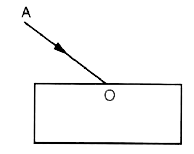Draw a ray diagram to show refraction through a rectangular glass slab. How is the emergent ray related to incident ray ? What is its lateral displacement ?
A ray diagram showing refraction through a rectangular glass slab has been shown in adjoining figure.

The emergent ray GH is exactly parallel to the incident ray EFNM. It means that ∠r2=∠i1.
However, the emergent ray is laterally (side ways) displaced as compared to the original path of light ray. In ray diagram, the lateral displacement is GN. Its value increases on increasing the width of glass slab.
Topper's Solved these Questions
- LIGHT - REFLECTION AND REFRACTION BOOK - U-LIKE SERIESCHAPTER - LIGHT - REFLECTION AND REFRACTION EXERCISE - LONG ANSWER QUESTIONS
14 Videos
- LIGHT - REFLECTION AND REFRACTION BOOK - U-LIKE SERIESCHAPTER - LIGHT - REFLECTION AND REFRACTION EXERCISE - VERY SHORT ANSWER QUESTIONS
49 Videos
- ELECTRICITY BOOK - U-LIKE SERIESCHAPTER - ELECTRICITY EXERCISE - LONG ANSWER QUESTION
18 Videos
- MAGNETIC EFFECTS OF ELECTRIC CURRENT BOOK - U-LIKE SERIESCHAPTER - MAGNETIC EFFECTS OF ELECTRIC CURRENT EXERCISE - LONG ANSWER QUESTIONS
18 Videos
Similar Questions
Knowledge Check
In an experiment to trace the path of a ray of light passing through a rectangular glass slab, four students measured the angles of incidence (i), angles of refraction (r) and angles of emergence (e) as shown in the diagrams :

The correct measurement is given in the diagram :AABBCCDDIn refraction of light through a glass slab , the directions of the incident ray and the refracted ray are …...............
Aperpendicular to each otherBnon-parallel to each otherCparallel to each otherDintersecting each other.A ray of light strikes a glass slab of thickness t. It emergens on the opposite face, parallel to the incident ray but laterally displaced. The lateral displacement, Δx is
AΔx=0BΔx = t sin ( I - r) cos rCΔx=t sin Icos rDΔx= t sin ( I - r)cos r
Draw a diagram to show refraction through a glass slab and label the following: (a) incident ray (b) refracted ray (c) emergent ray (d) angle of incidence (e) angle of refraction at the first boundary of two mediums (f) angle of emergence and (g) lateral displacement
View SolutionComplete the following ray diagram to show refraction of light through a glass slab and label the incident ray, refracted ray and emergent ray.

View Solution
In the adjacent diagram, AO is a ray of light incident on a rectangular glass slab.
(a) Complete the path of the ray till it emerges out of the slab.
(b) In the diagram, mark the angle of incidence (i) and the angle of refraction (r) at the first interface. how is the refractive index of glass related to the angles i and r ?
(c) Mark angle of emergence by the letter e. how are the angles i and e related ?
(d) Which two rays are parallel to each other ? Name them
(e) Indicate in the diagram the lateral displacement between the emergent ray and the incident ray. state one factor that affects the lateral displacement.
View SolutionFrom the course of a ray of light through a rectangular glass slab, explain what is lateral displacement and net deviation?
View SolutionDraw a ray diagram to show the refraction of a monochromatic ray through a prism when it suffers minimum deviation. How is the angle of emergence related to the angle of incidence in the position.
View Solution
